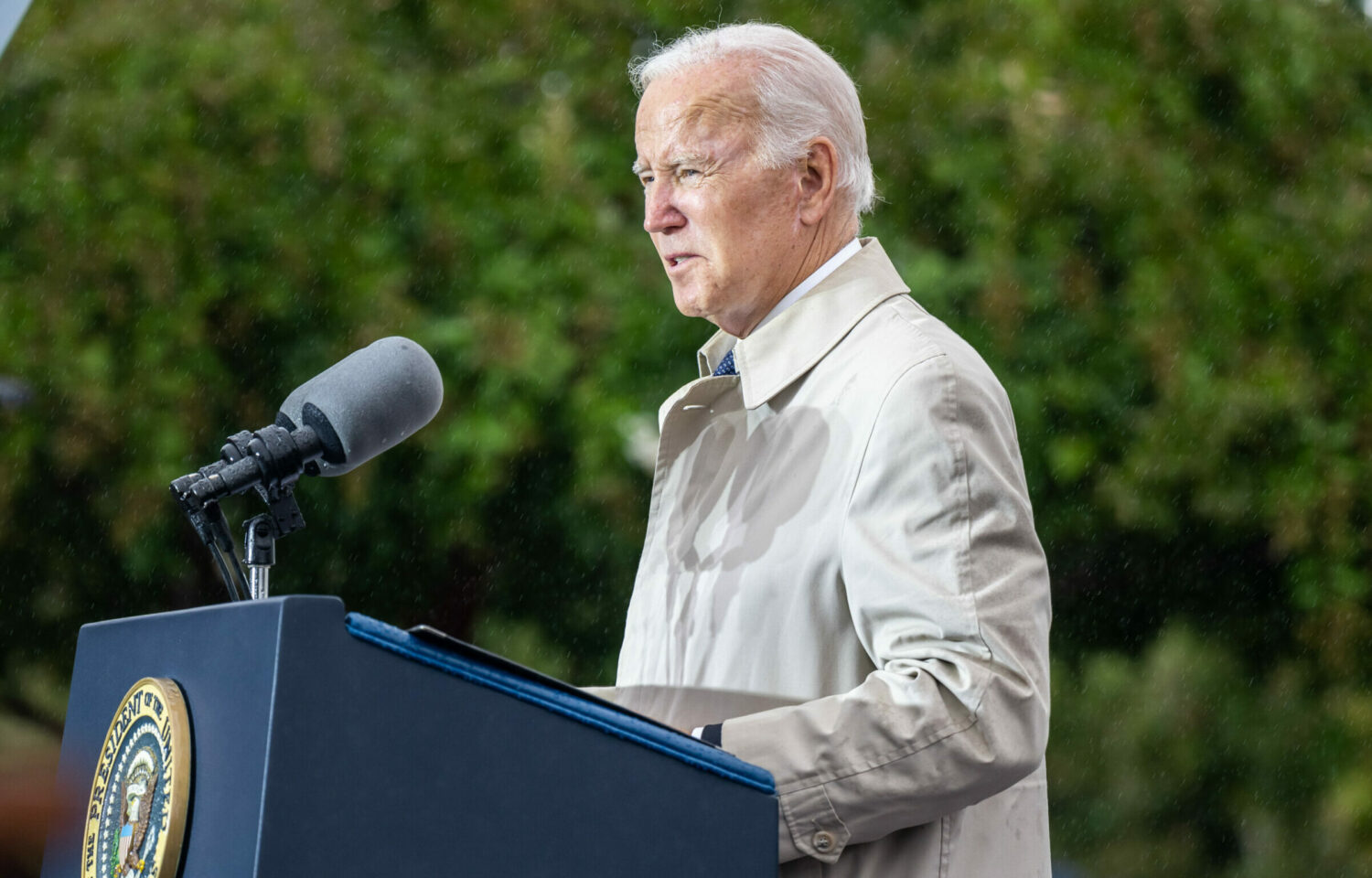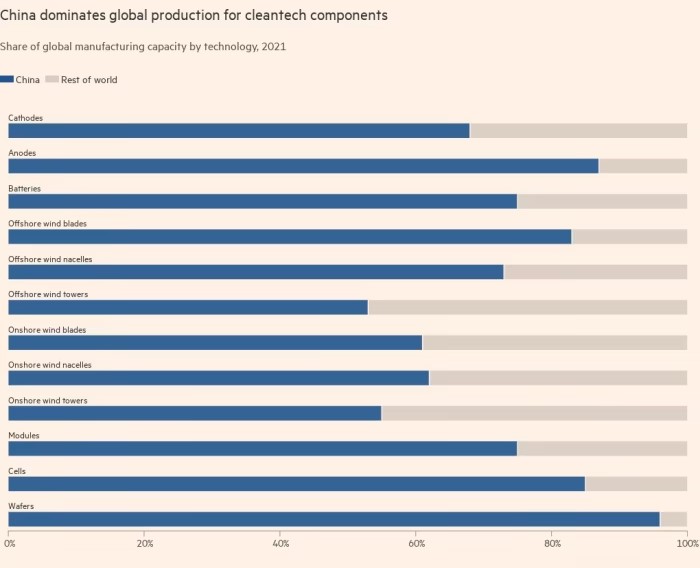The US and the EU lag behind China in clean technologies. Financial Times report

China dominates the production of clean technologies for the ecological transition: from batteries to solar panels to wind turbines, passing through basic components and metals. The United States and the European Union want to catch up: here's how
One cannot say ecological transition without mentioning China. As clearly highlighted by this graph from the Financial Times , Beijing truly "dominates" the global production of components for "clean technologies" – this is the name of all those devices useful for replacing fossil fuels: batteries, wind turbines, solar panels… -, with huge market shares.

THE DOMINANCE OF CHINA ON CLEAN TECHNOLOGIES
China, for example, alone accounts for almost 80 percent of the world's production of batteries for electric vehicles and energy storage, about 70 percent of the manufacturing of cathodes (positive electrodes) and around 90 percent of that of anodes (the negative electrodes). It also accounts for more than 80 percent of offshore wind turbine blade production and 60 percent of onshore wind turbine blade production. On wafers – thin squares of silicon, necessary for the construction of solar panels – it controls almost the entire global manufacturing, and about 80 percent of that of modules, the components that make up the panels.
THE US ANSWER
China's dominance of critical clean energy technologies is perceived as a threat above all by the United States, which has set itself ambitious goals on the ecological transition but fears developing a deep industrial dependence on its political rival, with everything that could achieve for national economic security and for the maintenance of "primacy" over the world.
The instrument that should prevent such a scenario is the Inflation Reduction Act , the 369 billion dollar law which provides generous incentives for low or zero emission technologies. As the Financial Times writes, in the United States “a new revolution is underway in sectors ranging from solar energy to nuclear energy, from carbon dioxide capture to green hydrogen – and its goals are profound: to rejuvenate the rust belt of country [the "iron belt", the old center of American heavy industry which then went into crisis, ed ], decarbonise the world's largest economy and wrest control of 21st century energy supply chains from China, the global superpower of clean technologies".
"There is no reason why wind turbine blades cannot be produced in Pittsburgh rather than in Beijing," US President Joe Biden said last April.
– Read also: Here are the Chinese companies that dominate the battery market
THE EUROPEAN UNION IS LOOKING FOR CARE
The tax cuts contained in the Inflation Reduction Act have made the United States "irresistible to investors", explains the newspaper, and the country is taking away the attractiveness of other regions of the world. Frightened by the American law, the European Union has drawn up its own plan to support green industry – the Green Deal Industrial Plan – which however does not envisage new resources, but reuses those already allocated for other purposes.
Since the Inflation Reduction Act went into effect in August last year, the United States has received investments in new clean energy projects worth $90 billion, according to data from Climate Power.
“The United States,” David Scaysbrook, a partner at private equity group Quinbrook Infrastructure Partners, told the Financial Times , “is now the most opportunity-rich, fastest-growing and most prolific market for renewable energy investment. And they will be for quite some time”. The European plan, on the other hand, has not been received as well by companies, who complain not so much about the size of the subsidies as about the bureaucratic difficulties and the long times of access to funds, which discourage investments.
The Inflation Reduction Act could "fragment the West," French President Emmanuel Macron said. According to the president of the European Commission, Ursula von der Leyen, it could instead be the cause of "unfair competition" and market closures.
PUBLIC EXPENDITURE AND PRIVATE INVESTMENT
America wants to become an industrial powerhouse of ecological transition through massive state intervention. According to the Credit Suisse bank, published spending related to the Inflation Reduction Act could reach $800 billion; if private spending generated by loans and grants is also counted, it could reach 1.7 trillion.
Wood Mackenzie estimates that, thanks to tax credits – which can cover up to half the costs of a battery factory – investments in energy storage in the United States will more than triple by the end of the decade, and by 2030 the annual additions of new storage capacity will have gone from 5 to 25 gigawatts.
The Inflation Reduction Act could make a difference not so much on already established clean technologies – such as those for wind and solar, on which China has a clear advantage – but above all on immature clean techs , which have yet to reach a large-scale production: e.g. green hydrogen , carbon capture and bioenergy.
THE RAW MATERIALS FOR CLEAN TECHNOLOGIES
It will not be easy, either for the United States or for the European Union, to recover the manufacturing disadvantage compared to China, which continues to allocate large sums to the energy transition: according to an estimate by BloombergNEF, last year it invested 546 billion dollars in the sector.
Furthermore, both America and Europe lack sufficient capacity to extract and process raw materials, such as lithium and cobalt for batteries, or rare earths for solar modules. China, by contrast, is worth 58 percent of global lithium refining capacity (the United States only 1 percent), 71 percent of graphite (the United States 5 percent) and 65 percent than that of cobalt (the whole of Europe 18 percent). As a result, Wood Mackenzie thinks that by 2030, the United States will account for 13 percent of world lithium battery manufacturing; two-thirds of production will remain concentrated in Asia-Pacific.
This is a machine translation from Italian language of a post published on Start Magazine at the URL https://www.startmag.it/energia/cina-dominio-tecnologie-pulite-transizione-ecologica/ on Sun, 26 Feb 2023 06:56:24 +0000.
